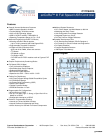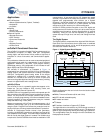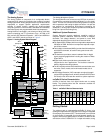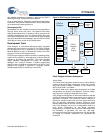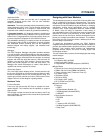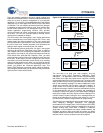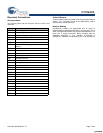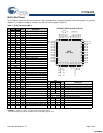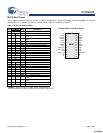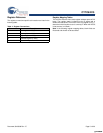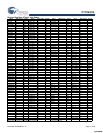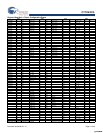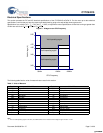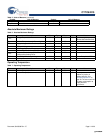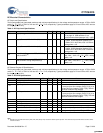
CY7C64215
Document 38-08036 Rev. *C Page 5 of 30
Application Editor
In the Application Editor you can edit your C language and
Assembly language source code. You can also assemble,
compile, link, and build.
Assembler. The macro assembler allows the assembly code to
merge seamlessly with C code. The link libraries automatically
use absolute addressing or is compiled in relative mode, and
linked with other software modules to get absolute addressing.
C Language Compiler. A C language compiler is available that
supports the enCoRe III family of devices. Even if you have never
worked in the C language before, the product quickly allows you
to create complete C programs for the enCoRe III devices.
The embedded, optimizing C compiler provides all the features
of C tailored to the enCoRe III architecture. It comes complete
with embedded libraries providing port and bus operations,
standard keypad and display support, and extended math
functionality.
Debugger
The PSoC Designer Debugger subsystem provides hardware
in-circuit emulation, allowing the designer to test the program in
a physical system while providing an internal view of the enCoRe
III device. Debugger commands allow the designer to read and
program and read and write data memory, read and write IO
registers, read and write CPU registers, set and clear break-
points, and provide program run, halt, and step control. The
debugger also allows the designer to create a trace buffer of
registers and memory locations of interest.
Online Help System
The online help system displays online, context-sensitive help
for the user. Designed for procedural and quick reference, each
functional subsystem has its own context-sensitive help. This
system also provides tutorials and links to FAQs and an Online
Support Forum to aid the designer in getting started.
Hardware Tools
In-Circuit Emulator
A low cost, high functionality ICE Cube is available for devel-
opment support. This hardware has the capability to program
single devices.
The emulator consists of a base unit that connects to the PC by
way of a USB port. The base unit is universal which operates with
all enCoRe III devices.
Designing with User Modules
The development process for the enCoRe III device differs from
that of a traditional fixed-function microprocessor. The config-
urable analog and digital hardware blocks give the enCoRe III
architecture a unique flexibility that pays dividends in managing
specification change during development and by lowering
inventory costs. These configurable resources, called enCoRe
III Blocks, have the ability to implement a wide variety of
user-selectable functions. Each block has several registers that
determine its function and connectivity to other blocks, multi-
plexers, buses and to the IO pins. Iterative development cycles
permit you to adapt the hardware and software. This substan-
tially lowers the risk of having to select a different part to meet
the final design requirements.
To speed the development process, the PSoC Designer
Integrated Development Environment (IDE) provides a library of
pre-built, pre-tested hardware peripheral functions, called “User
Modules.” User modules make selecting and implementing
peripheral devices simple, and come in analog, digital, and
mixed signal varieties.
The user module library contains the following digital and analog
module designs:
■
Analog Blocks
❐
Incremental ADC (ADCINC)
❐
Delta Sigma ADC (DelSig)
❐
Programmable Threshold Comparator (CMPPRG)
■
Digital Blocks
❐
Counters: 8-bit and 16-bit (Counter8 and Counter 16)
❐
PWMs: 8-bit and 16-bit (PWM8 and PWM16)
❐
Timers: 8-bit and 16-bit (Timer8 and Timer 16)
❐
I
2
C Master (I
2
Cm)
❐
SPI Master (SPIM)
❐
SPI Slave (SPIS)
❐
Full Duplex UART (UART)
❐
RF (CYFISNP and CYFISPI)
■
System Resources
❐
Protocols:
• USBFS
• I2C Bootheader (Boothdr I
2
C)
• USB Bootheader (BoothdrUSBFS)
• USBUART
❐
Digital System Resources
•E2PROM
•LCD
•LED
• 7-segment LED (LED7SEG)
• Shadow Registers (SHADOWREG)
• Sleep Timer
[+] Feedback [+] Feedback



